5•
Introduction to Branding
Branding is becoming an ever more important tool for marketing fashion. As companies manage to match each other with their ability to deliver appropriately priced, quality fashionable product, so something extra needs to come into play, something emotional and connecting. This is where the brand comes in. There is no doubt that marketing fashion has evolved. It is no longer just about the products themselves or ensuring that the right products are in the right place at the right time; now it is brand experience that differentiates. Lori Rosenwasser, Global Director of Brand Engagement at Landor Associates, suggests that, “We are now in the age of the experience brand” (2008). In a highly competitive marketplace, brand managers and marketers must find ways to augment products and services with emotional meaning and experiential dimensions. Allen Adamson, Managing Director at Landor Associates, describes branding as, “The process by which brand images get into your head” (2007). Branding is the mechanism by which a company creates and manages a brand and conveys the messages and values that underpin the brand to its customers. Branding is therefore a significant strategic activity for companies wishing to differentiate their products and services. This chapter introduces the key branding concepts, illustrating how these may be viewed within the context of fashion.
“A brand is the sum of the tangible and intangible benefits provided by a product or service and encompasses the entire customer experience.”
How Brands Work Chartered Institute of Marketing
Defining a brand
The concrete features of a brand are its logo, strapline, slogan, actual products and physical retail environment. But a brand is more than the sum of its parts – most of what constitutes a brand is intangible. In many ways the brand is a paradox, a composite shaped internally by company strategy and externally by consumer perception and experience. Formed from a unique mix of tangible and intangible elements, a brand is created out of a total package including not only garments, retail environment, packaging and advertising but also the meanings, values and associations that consumers ascribe to the brand. Walter Landor, a pioneer of branding, famously said, “Products are made in the factory, but brands are created in the mind.” Adamson defines a brand as, “something that exists in your head. It’s an image or a feeling. It’s based on associations that get stirred up when a brand’s name is mentioned” (2007). Influential and successful brands manage to engender positive or constructive associations in the minds of consumers, triggering emotions and feelings that can be extremely potent and affirmative. However, each consumer forms their own opinions so there is the possibility that they may develop negative perceptions and beliefs. It is therefore important for those who manage brands to consider carefully the associations that a brand conveys, making sure wherever possible that messages are transmitted by design rather than default. A brand must have clear points of difference, not only in the products and services but also at an experiential level. Consumers need to be aware of the brand’s existence, connect with its ethos and value what it has to offer – and of course the brand offering should be relevant to the needs, aspirations and desires of customers.

Flags display the brand names of luxury fashion, accessory and jewellery retailers on London’s Old Bond Street. The style and design of a logo and the colour of a flag form a significant manifestation of brand identity.

Chanel trademark quilted handbag with iconic interlocking C logo on the clasp.
The values, messages and ideas that underpin a brand will be expressed through:
•The brand name and logo
•The product
•Packaging and display
•The environment in which it is sold
•Advertising and promotion
•Company reputation and behaviour
The brand name and logo
The brand name and logo are tangible features that can be controlled from within the company. The logo provides the most fundamental visible element of the brand; the style of this unique identifier should capture and represent the essence or core idea behind the brand. Intelligent or ingenious use of colour, typeface and symbol can help to achieve a distinguishing logo that hopefully will stand as an iconic and trusted visual agent of the brand. Luxury fashion brands such as Gucci, Prada, Fendi or Chanel use fonts in upper case to create an aura of authority and tradition. Some brands add a crest or cartouche to enhance the logo and bestow an air of grandeur or heritage. Sports brands design their logos with the aim of generating a sensation of movement, speed or direction. Brands that wish to convey elegance or femininity tend to use lower-case script with flourishes and tails.
A well-designed and powerfully recognized logo is a great asset to a brand. The logo can be formed using the brand name, i.e. Gucci or Prada; Paul Smith uses his signature as the brand logo. Initials and letters can be exploited to construct a brand name such as DKNY (Donna Karan New York) or used to form a secondary logo, examples being the interlocking letters of Fendi, Chanel or Gucci. There are, of course, legendary brands such as Nike with its iconic Swoosh symbol, so powerful that it instantly identifies the brand without the need for any accompanying name or words. Similarly, the Fred Perry laurel leaf and the Lacoste crocodile also act as iconic emblems for their respective brands.
Trademarks
Brand logos, symbols, slogans and straplines can be registered. It is also possible to register elements of a design that are specific signifiers of a brand. Levi’s, for example, has registered the marketing slogan, ‘Quality never goes out of style’® and the Burberry iconic camel, black and red check became a registered trademark in 1924 when it was used as a lining for the Burberry trenchcoat. A registered trademark gives the brand company exclusive rights over usage of the registered article. This helps to protect the brand from piracy or unauthorized use of the trademark. Once a mark is registered it can be indentified by the ® or ™ symbol.
A small business intending to trade in their home market can register their mark for exclusive use in their national market. But to ensure more comprehensive protection, it is sensible to be internationally registered.

Logos for adidas Performance and adidas Originals. A logo should represent the essential nature of a brand in a simple and easily recognizable format.
The international sports brand adidas has an instantly recognizable logo featuring its quintessential three-stripes motif. The classic adidas emblem has been modified to create logos for the adidas sub-brands.
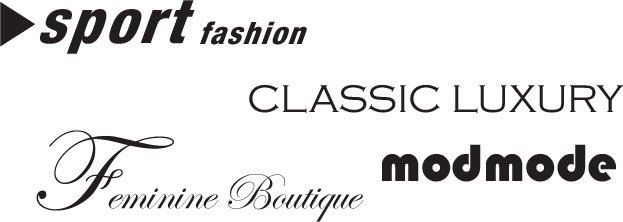
When creating logos it is important to consider the underlying message and choose a typeface accordingly. The stretched font and forward direction of the sport logo below creates a feeling of momentum. An uppercase copperplate Gothic Light typeface communicates the timeless authority of heritage and luxury. The italicized Edwardian Script adds a feminine touch to a logo. A contemporary modern look with a retro feel is created using the Bauhaus 93 typeface.
Fashion product provides a fantastic canvas for branding. Logos can be emblazoned boldly on T-shirts or used more subtly in placement embroideries. Denim brands use trademark stitching on back pockets to identify their jeans or use labels, like the iconic Levi’s red tab. When designing branded product, think about how to incorporate brand insignia. Clasps, clips, buckles and zips can all be developed so as to include recognizable and identifying symbols or emblems, and fabrics can be woven or printed with trademark stripes, checks and patterns.
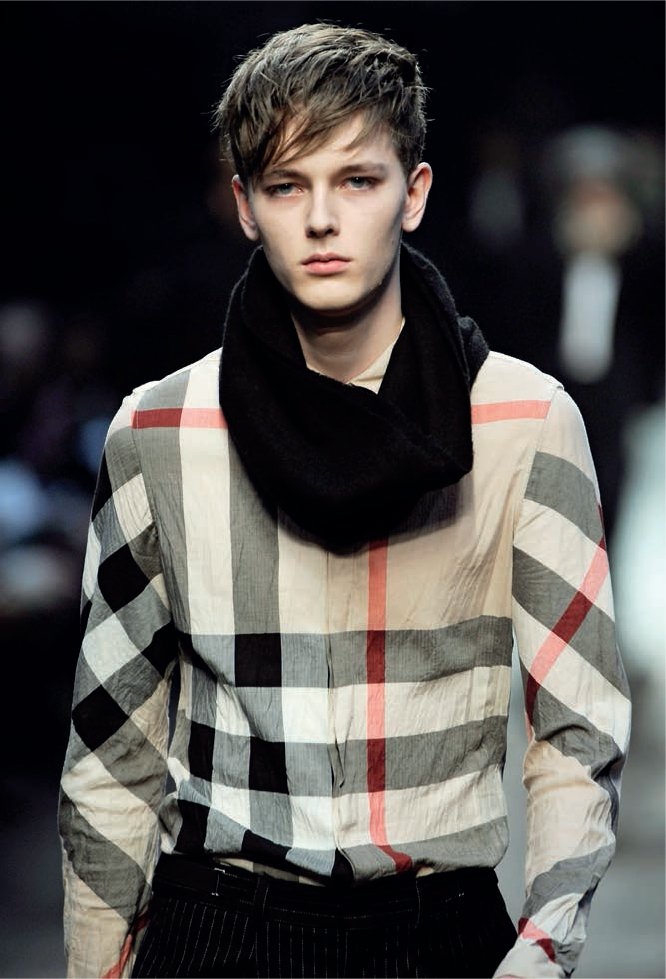

Burberry’s distinctive check is utilized by the brand for many of its products. Here it is used for the menswear collection. The scale of the check has been enlarged significantly but it is still instantly recognizable as a signifier of the brand.

The Fred Perry tennis sweater is branded with an embroidered laurel leaf – the signature trademark of the brand.
Jeremy Scott’s fringed hooded top for the adidas ObyO collection.
The adidas Originals by Originals (ObyO) limited-edition collection created by adidas in collaboration with New York fashion designer Jeremy Scott exemplifies how a logo can be integrated within a garment design to creative effective branding. Scott takes an inventive approach by partly concealing an oversized adidas Originals emblem with layers of fringing.
Brands exist at every level of the fashion industry. There are branded fibres, branded textiles, sports brands, designer brands such as Armani or Donna Karan, luxury brands like Louis Vuitton or Hermès, iconic couture brands like Dior, fashion retail brands, and even department stores that have achieved brand status. Defining types of brand can be complicated, however they can be categorized as explained below.
Corporate brand This is where an organization has one name and one visual identity across its brands. The corporation is the brand.
The Sri Lankan manufacturing corporation, MAS Holdings, has this kind of structure: MAS Intimates produces lingerie and intimate apparel for global customers such as Marks & Spencer, Gap and Victoria’s Secret; MAS Active is a supplier of active sports and casual wear to Nike, Adidas, Reebok, Gap and Speedo; and MAS Fabric develops fabrics, elastics, lace and other garment components.
Manufacturer brands These are created and marketed by producer companies who will choose a name for their branded product. Manufacturer brands are prevalent within the fibre and textile industry where chemical manufacturers brand their fibres. The science-based company DuPont™ for example manages the well-known fibre brand, Lycra®. Another DuPont™ brand is Kevlar®, utilized in garments worn by workers exposed to a variety of hazards including abrasion and high levels of heat. NatureWorks LLC, a joint venture between Cargill and Teijin of Japan, produce Ingeo™, a branded fibre made from renewable plant resources derived from corn. The avant-garde French fashion label Marithé + François Girbaud selected Ingeo™ to use in their first eco-inspired designs, launched in 2008.
Private brands Private brands are also known as own brands, store brands, retailer brands or own label. The US department store, Nordstrom, offers its own brand, Classiques Entier, and Macy’s offers a wide portfolio of private label brands, including I.N.C. and Tasso Elba. Private brands raise the profile of a retailer, differentiate its offering and add value for customers. Retailers tend to favour them because they offer opportunity for higher margin than selling designer-branded merchandise.

Swing tickets developed to promote Woolmark sub-brands, Cool Wool and Merino Extrafine. Each sub-brand has its own specially developed logo and is endorsed with the universally accepted Woolmark symbol. Each swing ticket is further branded with the Woolmark strapline, ‘Take Comfort In Wool’.
Endorsed brand This is when a parent brand gives its name or endorses one of its own sub-brands. The names of the parent and sub-brand are linked. Examples would be Polo by Ralph Lauren or the perfume Obsession by Calvin Klein. The endorsement gives credibility to the sub-brand while also capitalizing on the status and reputation of the existing main brand.
Co-brands or partnership brands A co-brand is created when two brands join together to develop a new brand. The Japanese designer Yohji Yamamoto has two co-brands – Y’s Mandarina, a bag and accessory collection for men and women created in conjunction with the luggage and accessory brand Mandarina Duck, and adidas Y-3 (also known as Y-3), a collaborative brand project with adidas. Y-3 takes its name from the ‘Y’ from Yamamoto and the three stripes of the adidas logo.
Brand portfolio When a company has a brand portfolio the aim is to maximize coverage of the market without the individual brands within the portfolio competing with each other. The multiple brands within the company will be designed to address specific needs across different key segments within the market. The Gucci Group’s brand portfolio includes prestigious and clearly defined luxury brands, including Gucci, Alexander McQueen, Stella McCartney, Balenciaga, Bottega Veneta and Yves Saint Laurent. The Adidas Group has a brand portfolio that includes Reebok, Rockport, the shoe company, and TaylorMade, which is a golf brand.
“Brands help businesses cross geographic and cultural borders. Global brands are an enormous asset to their home country. They aid exports of products and services to foreign markets.”
Clamor Gieske, FutureBrand
The purpose of branding
The purpose of branding is to establish a clear and distinctive identity for a product, service or organization. The aim is to ensure that the brand is differentiated and that it offers something distinguishable from competitor brands. Branding should also add value or increase the perceived value of a product, allowing a company to charge a premium for its branded merchandise. On a more complex level, branding works to create emotional connection between customers and the brand. It raises not only the consumer’s potential financial outlay but it can also affect their emotional investment in the brand. A pair of Nike trainers, for example, is not just a pair of running shoes but ‘my Nikes’, imbued with additional associations and meaning. In a pair of Nikes ‘I can do it’. This is why a brand can be so powerful and influential – the Nike wearer might feel more committed and better able to get up early and run, they might believe themselves to be more sporty, active and alive when they wear this particular brand. Consumers are therefore more likely to engage constructively with a brand and purchase its products if the brand satisfies several criteria. The brand’s products and services must have relevance to their life and needs, the consumer should identify closely with the brand ideology and style, and their association with the brand should trigger positive or affirmative feelings and emotions.
Branding should generate reassurance and a sense of security and trust for customers. If they have connected emotionally with a brand and want what it has to offer then the hope is that they will remain loyal. It is important therefore that the brand remains consistent and continues to deliver the values and promises that customers expect.
The issue of brand continuity is an extremely important factor within the fashion industry. This is because two contrasting factors – newness and consistency – need to be integrated season after season. Customers will naturally demand choice and want to be tempted with fresh merchandise each season, but they also require some sense of stability when engaging with a brand. This presents a challenge to designers who must create and develop new product collections on a regular basis. They must ensure the integrity of the brand remains intact and create the sensation of permanence for customers, even when the products in-store change on a frequent basis. Even though the theme, concepts, colours and fabrics might be different for each seasonal collection, the overarching branding, brand message and values need to remain consistent.
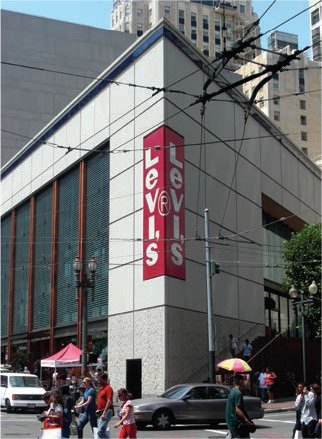
Levi’s trademark red tab outside their flagship store in San Francisco.

The iconic Swoosh is used to brand the Niketown store.
Branding is essentially about building a relationship between consumer and brand. This is why a thorough knowledge and understanding of consumers is so vital and why companies invest so much time and money in consumer and market research. The more intimately a company understands its customers, the better able it is to develop products, services, retail environments and marketing strategies that encourage consumer engagement, promote loyalty and foster trust in its brand.
So to summarize; the aim and purpose of branding is to:
•Tap into values and beliefs
•Create connection
•Generate emotional response
•Provide reassurance
•Ensure consistency
•Build loyalty
•Add value and charge a premium
An important element of branding is to develop and establish what is known as a brand identity. This is one of the foremost tactics for achieving the emotional connection with a target audience that is so vital to the concept of branding.
Brand identity
Brand identity is controlled from within an organization and should relate to how the company wishes consumers to perceive and engage with the brand. People use brands, and fashion in particular, to make statements about themselves – the meanings and associations consumers have with brands will be closely connected with how they want to feel, how they want to be seen and how they wish to be perceived by others. Consumers are more likely to connect positively with a brand if they associate closely with its overall identity and ethos. It is extremely important therefore for an organization to develop a compelling and engaging identity for its brand. The identity will be built up using the following:
•The logo
•The product and services
•Packaging
•Retail environment
•Windows and visual merchandising
•Promotion, advertising and PR
•Website
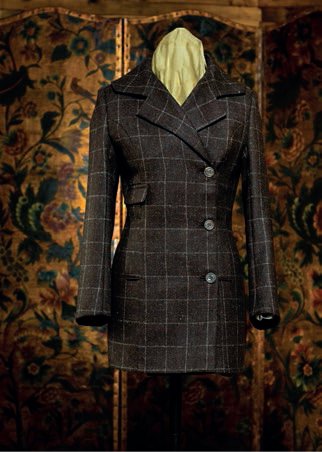
Eloise Grey’s ‘Toklas’ checked wool jacket, named after the American writer Alice B. Toklas. Inspired by a love of literature, the British designer has named the jackets and coats in her collection after writers such as de Beauvoir, Waugh and Beckett, evoking the tweedy world of twentieth- century authors.
Each outward expression of the brand as listed above will work towards building up the brand identity. One simple way for a fashion designer to strengthen their brand identity and connect with a fashion audience is to bestow garments with names to captivate the imagination. Erdem gives luscious and evocative names to all the garments in his collection. The ‘Felicitas’ jewelled dress, the ‘Invidia’ silk blouse and the ‘Laverna’ skirt all featured in the Erdem Autumn/Winter 2008 Collection. Isaac Mizrahi adds a splash of humour to his collections with colour names such as ‘Lorne Green’, ‘Burlapse’ and ‘James Brown’. Subtle details such as these set an emotional tone and help make a brand and its products memorable.
It is important to point out, however, that consumers will interpret all of a brand’s signifiers and form their own impression of the identity. It is vital therefore, that each and every manifestation of the brand upholds the identity coherently and consistently. The image of the brand from a consumer perspective is known as the brand image.
Brand image
The image of a brand will differ depending on whether it is formed by a brand-user or non-user or someone who has a business association with the brand such as a supplier or stakeholder. Someone who is a devoted customer of a brand would compose their image based on actual experience. Take someone who regularly purchases from Ralph Lauren. They may visit the same flagship store frequently, be consistently served by a specific staff member and build up a very personal relationship with the brand and its products. Another person may aspire to the Ralph Lauren lifestyle, but believe the designer clothes to be expensive or extravagant. They might buy into the brand on a rare occasion by purchasing sunglasses, perfume or homeware from a department store such as Bloomingdales or Selfridges. A fashion-aware non-user would generally construct their brand image from magazines; looking at the adverts, fashion spreads and reading the editorial content.

A lily provides inspiration for a colour palette and for the name given to each of the colours.
They may also form judgements by absorbing the opinions of others. The power of a brand rests in its relationship with consumers, so every interaction a customer or potential customer has with a brand is important as it will contribute to their brand experience, either positively or negatively.
The company behind a brand needs to ensure that there is a close match between the identity they control and the brand image as perceived by outsiders and consumers. A large gap between identity and image can result in catastrophic problems for a brand. There have been cases where companies have lost control of their identity. This happened to Burberry when consumers it had not intended to attract started purchasing both legitimate Burberry product and counterfeit products. The skewed image of the brand affected its identity, which no longer related to the strategic intentions within the company.
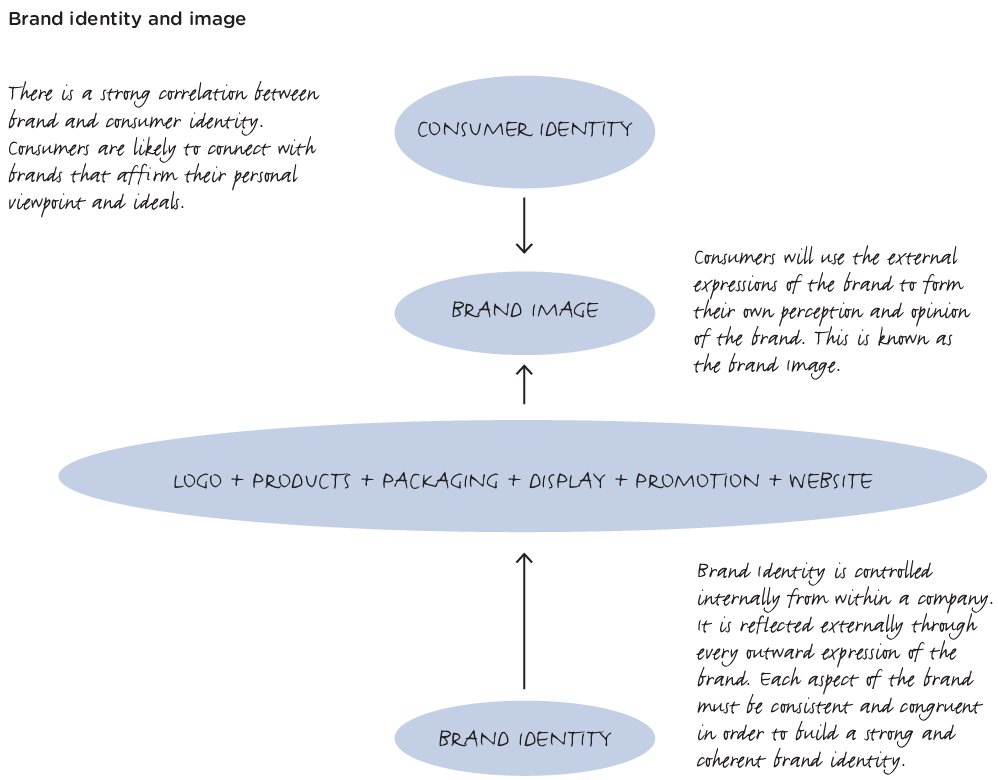
Identity and ideology
Davidelfin
The Spanish fashion label Davidelfin was launched in Barcelona in 2002 by a multidisciplinary group of artistic individuals that included a professional model, a journalist, an architect, a film director and musician, and the figurehead, David Delfin, a self-taught designer. In 2003 David Delfin won the Marie Claire Prix de la Mode for best new designer of the year.
In an interview with Mariona Vivar Mompel for cafebabel.com in 2006, Delfin commented that young designers starting out faced difficulties because the market is at saturation point. “This means that in order to stand out in the fashion industry you need two things: your own identity and ideology.” Delfin believes that to succeed it is necessary to be something more than mere fashion designers. “Nowadays you have to be able to awaken emotions.” This point is well illustrated by the name and ideology behind the new davidelfin sub-brand, Da Davidelfin, aimed at the younger customer. The word ‘Da’ comes from the Spanish verb ‘to give’ and the collection is marketed with the statement, ‘Understanding fashion is an act of generosity. Made with love’ and signed ‘davidelfin’. Launched in 2007 at the European fashion tradeshow Bread & Butter in Barcelona, the new davidelfin second line is defined as a ‘sports couture’ concept and consists of T-shirts and casual clothes aimed at men, women and children.
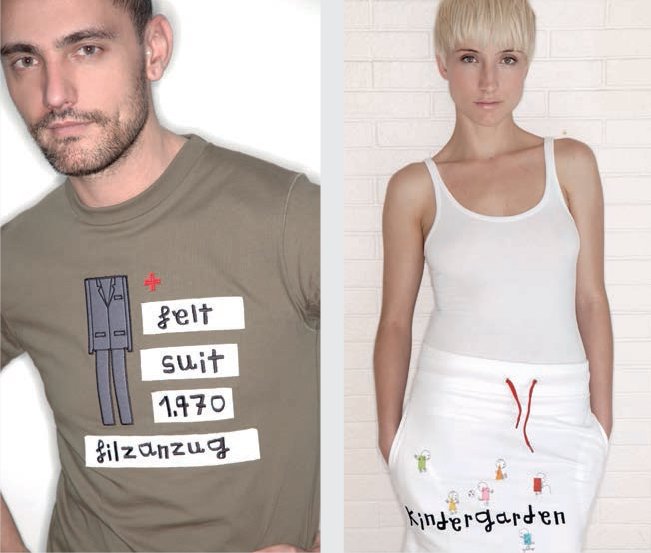

Da Davidelfin garments printed with the text using the same distinctive left-handed script as the brand logo.
Developing and managing brand identity
Developing and managing the brand identity is an extremely important aspect of brand management. A brand is a precious commodity and a valuable asset for a company – a powerful brand name, brand logo and brand identity as well as the accumulated goodwill that exists towards the brand all contribute to the brand equity or total worth of the brand as an asset. A brand with high equity and a strong identity can command a price-premium for its product, which is one of the main purposes of branding. Those managing a brand need to ensure that there is a close match between the brand identity created and managed from within the company and the brand image held by consumers and others outside the company. In order to develop and manage an identity effectively it is important to understand that it is formulated from three key constituents:
•Brand essence
•Brand values
•Brand personality
The brand essence, values and personality govern the overall character and feel of the brand; they give the brand its meaning and uniqueness and serve to differentiate the brand from others in the marketplace. These are vital components of the identity and should be reflected in the outward manifestations of the brand – its symbol or logo, product, packaging, display, promotion and website.
Brand essence
The first step in defining brand identity is to determine and establish the brand essence. A brand’s essence describes the essential nature or core of a brand. It could be described as the brand’s heart, spirit or soul. It is extremely important to understand what lies at the heart of a brand and to be able to articulate it concisely. Edun, for example, launched by Ali Hewson and Bono of U2, describes itself as “A socially conscious clothing company with a mission to create beautiful clothing while fostering sustainable employment in developing areas of the world, particularly Africa.” (www.edunonline.com).This short statement identifies the fundamental aim of the brand, marks out its central proposition and sums up its essence. Writing a statement such as this is important as a clearly defined essence forms the key building block upon which all other aspects of the brand are built.
Closely allied to the brand essence is the brand proposition, which is a succinct expression of what the brand intends to offer or promise its customers. The Edun statement above clarifies the Edun brand essence but it also explains the Edun brand proposition as shown overleaf.
Edun brand essence – a socially conscious clothing company
Edun brand proposition – to offer beautiful clothing while fostering sustainable employment in developing areas of the world
As you can see from the example above, the essence and proposition (or promise) explains the raison d’etre behind the brand and clarifies the motivation for the business. A genuine brand essence in combination with an achievable and deliverable proposition will contribute to creating a well-defined brand identity which in turn can act as a potent force for marketing and set the tone for communication and promotion. If essence is considered to be the heart of a brand then brand values (sometimes referred to as core values) are its foundation stones.

Building brand loyalty
Brand identity and the brand values upon which it is built should be considered important tools for establishing brand loyalty. Authentic brand values and an engaging brand identity are powerful communication tools, but if consumers engage with a brand because they respect what it stands for they will want to feel confident that the values will be upheld over time. A company managing a brand must ensure that customers’ loyalty and trust are honoured and that the brand identity and values are maintained and remain consistent. The diagram above shows the impact on consumer loyalty of both a positive and negative brand image. If a consumer forms a positive image, they are likely to remain loyal and become advocates of the brand. If the brand fails to deliver, they will be disappointed and form a negative image.
Brand values build upon and expand the central theme of the brand essence. They are the core values that set the code by which a brand organization operates. The values should inform all aspects of how the company runs its business, designs and develops its products, delivers its services, and markets and promotes its brand. Consumers are more likely to engage with a brand when they respect or connect with its values, as the title of Martin Butler’s book testifies, People don’t buy what you sell: They buy what you stand for.
Comptoir des Cotonniers, created in 1995, is an upmarket French fashion retail brand owned by Japanese parent company Fast Retailing – the company that also owns Uniqlo. Comptoir’s central value is to appeal to women of all ages and to create a close connection with its customers. To that end they do not use professional models but showcase their collections using “real mother and daughter pairs, who over the passing years and seasons, embody and affirm the brand values with ever more naturalness, enthusiasm and pleasure.” (www.comptoirdescotonniers.com). The Comptoir brand values are to be accessible, contemporary and to promote sharing and what they term proximity – meaning close and authentic relationships as demonstrated in mother and daughter relationships.
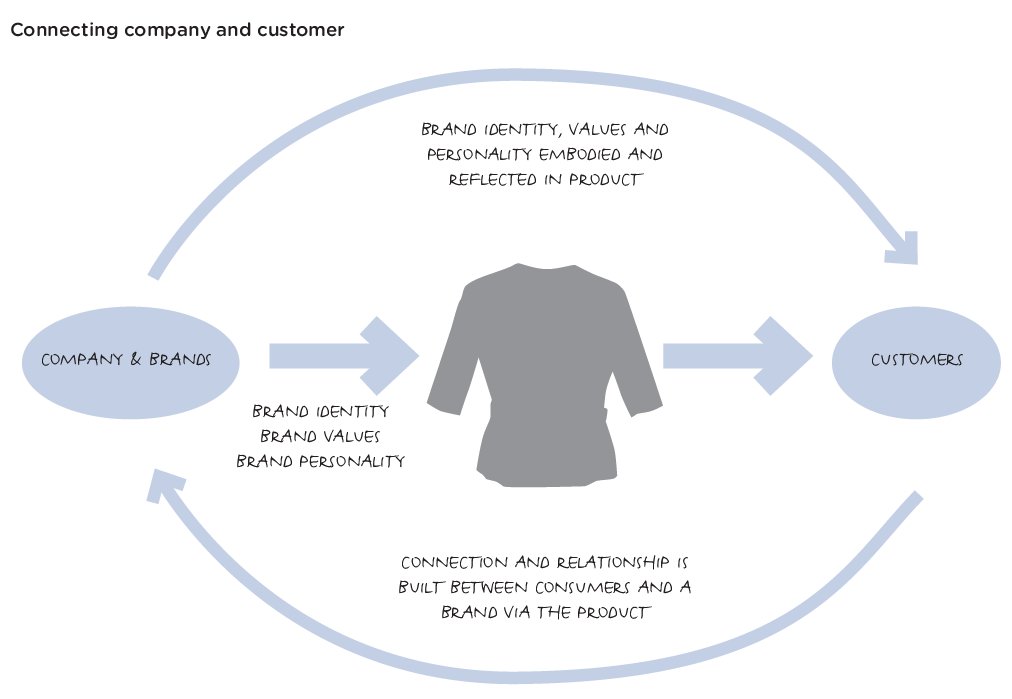
A small clothing company with big brand values
Nau
Nau is a US company selling its own design range of sustainable fashion and performance wear. The team behind the Nau label describe the company as “a small clothing company with big ideas”; they understand the potential of building a brand up from its core values and are committed to the power of business as a force for change. As a business Nau seeks to balance the triple bottom line: people, planet and profit. The triple bottom line is an ethical system that measures a company’s success in terms of economic, social and environmental criteria. The ethical stance taken by Nau leads the company to pose the question: “Does the world really need another outdoor clothing company?” Only if its products and practices contribute to “positive, lasting and substantive change”, they reason.
The Nau website also explains the company design philosophy is: “Built on the balance of three criteria: beauty, performance and sustainability.” From these statements it is possible to extrapolate the Nau core brand values:
•To contribute to positive, lasting and substantive change
•To produce and sell clothes that balance beauty, performance and sustainability
Brand values should be more than just a list of impressive sounding words. They should be a call to action. The idea is to create values that inspire and drive a business forward. The values should be understandable and deliverable; those that manage a brand will need to instigate strategic actions to ensure the values are manifested throughout the company. Valid and authentic brand values strengthen the brand identity, give a business direction and provide motivation for management, stakeholders, partners and employees. Brand values are important not only in terms of their potential for guiding the internal business operation but also for building relationship and communicating with consumers. Websites provide an obvious advantage for businesses wishing to communicate their ethos and brand values. The Nau site explains the philosophy behind the company and details how this is reflected in the product design and manufacture.

The Profile Fleece jacket made from recycled polyester fabric developed from post-consumer and post-industrial polyester waste.

The Nau team at work. Valid and authentic brand values strengthen the brand identity, give a business direction and provide motivation for the team.

Beauté Prestige International (BPI) creates, develops and markets fragrances for Jean Paul Gaultier, Issey Miyake and Narciso Rodriguez. The Jean Paul Gaultier perfume, Ma Dame, was launched in 2008; BPI worked with branding consultancy Interbrand to define the personality for the perfume, inspired by Gaultier’s vision of the perfect woman. Ma Dame’s personality is described by Interbrand as a “trendy tomboy with classy sex appeal”.
Brand personality works on the premise that brands can have personalities in much the same way as people. Professor Kotler, when describing the differences between the computer brands IBM and Apple, suggested that Apple has the personality of someone in their twenties and that IBM has the character of someone in their sixties!
When related to fashion, the issue of brand personality needs some careful thought. It is all too easy to say that a brand is fashionable, stylish, modern or luxurious. But do those characteristics really capture the flavour of its personality or distinguish the brand clearly from any other? Probably not! The Vivienne Westwood label could be described as British fashion with a twist, so could that of Paul Smith, so it is vital to take some time to delve deeply and define other more descriptive qualities that capture the uniqueness of a brand’s persona. Vivienne Westwood is also anarchic, irreverent and perhaps a little subversive, whereas the Paul Smith brand augments its British style with quirky elements of the unexpected.
When a brand is built around the distinctive personality of an individual designer, the brand personality is likely to resemble closely that of the designer in question. New York fashion designer Betsey Johnson has variously been described as exuberant, whimsical, over the top and fearlessly eccentric. Betsey’s dramatic personality is reflected throughout her fashion empire. Her collections are known to be colourful and capricious with sexy silhouettes and whimsical embellished details. The Betsey Johnson retail stores (there are over 50 worldwide) amplify her singular creative vision with an iconic rock-n-roll meets Victoriana style defined by bright colour, abundant floral wallpapers and bursts of ornamental decoration. As Betsey says on her website:
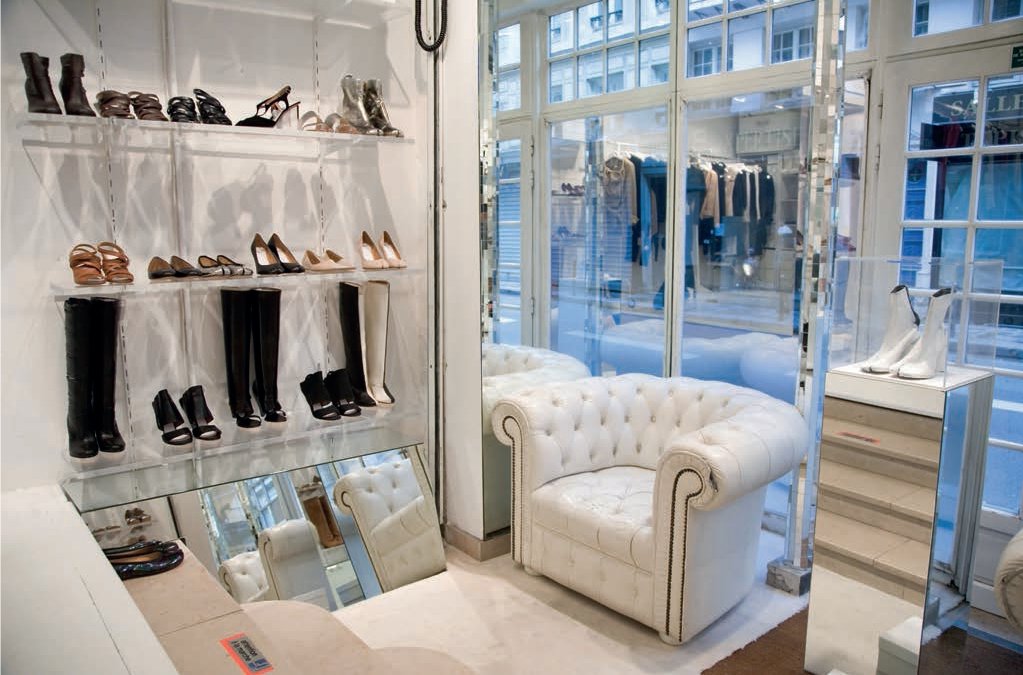
Maison Martin Margiela stores are all decorated in white, the brand signature colour. The individual collections are given a number rather than a name.
“My products wake up and brighten and bring the wearer to life…drawing attention to her beauty and specialness… her moods and movements… her dreams and fantasies.”
Betsey Johnson
In comparison to Betsey Johnson it could be said that the Martin Margiela brand sits at the opposite end of the personality spectrum, particularly in terms of colour. Whereas Betsey Johnson draws attention by use of bold bright colour, Margiela creates drama by the use of white. White is the signature for all Margiela boutiques. Sales personnel are styled in labassistant white coats – the uniform traditionally worn by workers in a Parisian couture atelier. The signature use of non-colour could be described as selfeffacing, like the Belgian designer himself. Famous for keeping a low profile, he has been described by journalist Sarah Mower as “fashion’s mystery man”. This desire for secrecy exudes from many aspects of the brand personality and identity. A noticeable example of inscrutability is evidenced in the garment label for the women’s collection. It is not woven or printed with the Maison Martin Margiela brand name but is left blank. For the other collections, the label is constructed from a simple piece of white cloth printed with a series of numbers 0–23. The specific collection is indicated by encircling the appropriate number on the label. The key to the numbers and the collections is represented below.
0 Garments reworked by hand for women
010 Garments reworked by hand for men
1* The collection for women
10 The collection for men
4 A wardrobe for women
14 A wardrobe for men
11 A collection of accessories for women and men
22 A collection of shoes for women and men
13 Objects and publications
MM6 Garments for ![]()
* The original white label
Basia Szkutnicka is a fashion lecturer and Maison Martin Margiela devotee. She has been wearing and collecting Margiela clothes and accessories since the label launched in 1988. In a conversation with the author in 2009, Basia explained why she connects to the Margiela brand.
“I love the irreverence and the intelligence… I feel I connect with the ethos of the label… I love the attention to detail, the garments flatter me, they are an extension of me… I love the tradition, craftsmanship and the values of the product. I feel really well dressed – it’s like a second skin to me.”
This connection to the ethos behind the Margiela brand is mirrored in an interview with a fashion journalist conducted by Mark Tungate. In his book Fashion Brands Tungate relates how this well-known journalist had two jackets with them for a trip to the Paris collections; one from Margiela, the other was from Zara. The Margiela jacket cost around five times the price of the Zara garment but the journalist did not mind paying this premium because as they explained,

Each Maison Martin Margiela collection is given a number rather than a name. MM6 is a line for women that is more casual and edgy than the main line, MM1.
“I like what Margiela stands for. I’m paying for the person, not the article.”
(Tungate, 2005)

Maison Martin Margiela store signage features no name, just the numbers 0–23.
This illustrates the potential of brand personality as a tool for building relationships between a brand and its customers. The product is the visible symbol of the personality and a physical manifestation of the brand values. On the company website, the design aesthetic of the Edun collection (see pp.139–40) is described as being edgy with a modern approach and drawing inspiration from intellectual ideas behind poetry and art. The Edun brand personality could therefore be described as edgy, modern, intellectual, brainy, beautiful, ethically conscientious and socially aware. It is likely therefore that the brand will appeal to consumers who connect with these personality traits; they are likely to be socially aware ethical customers who might wish to feel edgy and intellectual or modern and beautiful.
The carrier bag is a highly visual symbol of a brand. This simple item is often overlooked as a marketing tool but just think about it – every time a customer leaves a store carrying their purchases in a distinctive and recognizable carrier bag, they become a walking advertisement for the brand. For many customers, the bag is considered to be an important element of the shopping experience and deemed just as much of a status symbol as the garments or product contained within it. It is an amazingly democratic device, available to all who purchase irrespective of the amount of money they spend.
Brand touchpoints
Fashion product is one of the most important vehicles through which a brand transmits its message, values and identity to customers. The product can be described as a brand touchpoint, which is a point of interaction between a brand and consumers, employees or stakeholders. The concept of brand touchpoints was first published in 2002 by Davis & Dunn. A brand has between 30 and 100 potential touchpoints and each touchpoint has the potential to make either a positive or negative impression (Davis & Longoria 2003). Touchpoints affecting consumers can be categorized into those that occur pre-purchase, during purchase and post-purchase. Think about all the possible interactions a consumer could have with a brand. Each touchpoint offers the potential for someone to be converted either for or against the brand. Take, for example, the pre-purchase stage. A person who is not aware of the brand may be converted to become conscious of it. Someone who is brand-aware may be converted and take the next step towards actually purchasing. During the purchase stage a potential customer may be converted and make a purchase, or they may be put off in some way by their experience and decide not to buy and not to interact with the brand again.

The carrier bag is a highly visual symbol of a brand. This simple item is often overlooked as a marketing tool.

The touchpoints that affect a consumer when they interact with a retail fashion brand during the pre-purchase, purchase and post-purchase stages. There can be between 30–100 touchpoints, but it would be impossible for a company to focus on all of these effectively. A limited selection of key touchpoints must be identified. For an internet-based retailer, the website would be an extremely important touchpoint.
Source: Adapted from Davis & Dunn (2002).
Analysing brand identity
Brand touchpoints represent a point of interaction between a consumer or potential consumer and a brand. These touchpoints could also be considered as the brand in action, or in other words, the way in which a brand expresses its ethos and identity in actual strategic actions. This takes us on to a tool used in brand management known as a brand onion.
A brand onion is used to analyse and map the brand identity and show it in diagrammatic form. The brand onion represents the layers of a brand from its inner essence, or core, through to the outer personality layer and brand in action at the surface. The object of the exercise is to summarize the brand identity, capturing the essence, values and personality traits that differentiate the brand from competitors. The real benefit of the tool is its use in establishing how the identity should be made manifest in reality, represented by the ‘brand in action’ section of the diagram. So, for example, Comptoir des Cotonniers (see page 141) aims to be accessible; how exactly will this accessibility be realized? As we saw earlier, one way Comptoir reflect this value is to use real people to model their clothes. They also want to promote authentic relationships, so they use mother and daughter pairs to express this aspect of the brand.
Creating a brand onion
When analysing a brand and developing a brand onion, it is often easiest to start with the personality layer first. Look at websites, in-store promotional material, carrier bags, labelling, window displays, in-store ambiance or advertising – what kind of personality do you think they convey? How do you feel when you connect to the brand or how do you think customers feel when they wear the brand?
Work inwards through the brand onion and determine the brand values and the essence. Finally, don’t forget the brand in action section. Try to determine how the brand essence, values and personality are put into action and record findings in the outer ring of the onion.
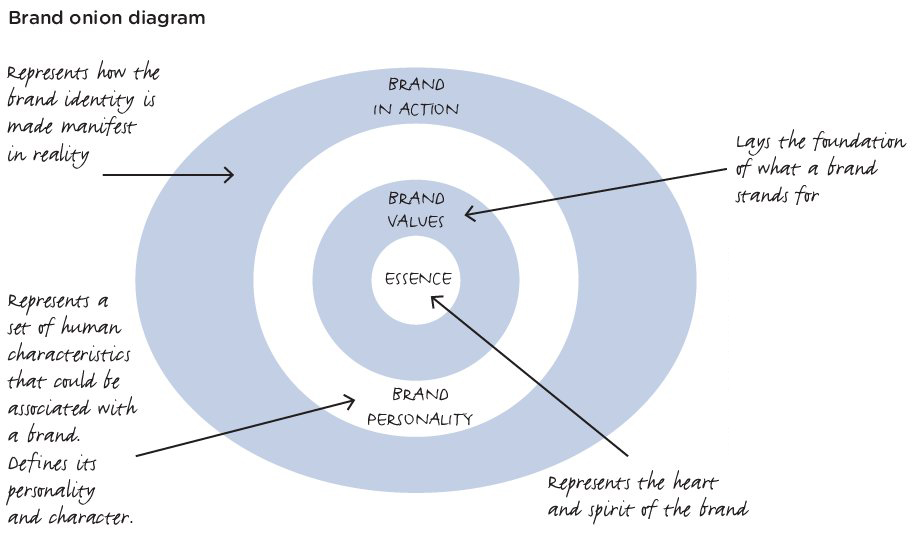
The brand onion is a popular and effective device for showing a concise overview of a brand identity and how it is expressed in actual strategic actions. Brand onions are usually created by branding consultancies to show the results of a brand investigation or re-branding exercise. Once completed, the onion can be used as a guide to ensure that all aspects of the business and key brand touchpoints accurately reflect the brand values.
A new fashion brand and collection
Grandma’s Trunk
The brand proposal showcased here forms part of a project undertaken by a student studying fashion at Plymouth College of Art in the UK. The student has set the scene and outlined the concept for the brand, Grandma’s Trunk.
Grandma has a hidden trunk full of secret treasures. Dresses, brooches, old ribbons, buttons and scented love letters have remained preserved and undisturbed for decades. It’s a girl’s dream to rummage through this treasure trove and unearth vintage gems that could inspire new ideas or spark off a trend. Grandma’s Trunk transforms faded treasures into delightful, edgy new garments with a surprising, vintage, rock-chic feel. The girl who wears this quirky new brand is adventurous, eclectic and confident. She radiates happiness, is admired as a trendsetter and experiments with creating her own special style by mixing vintage with raw classics.

A brand onion showing how the personality of the Grandma’s Trunk brand matches closely the personality of the targeted customer. The brand onion also shows how the potential customers might feel when they connect with its quirky mix of vintage and modern.
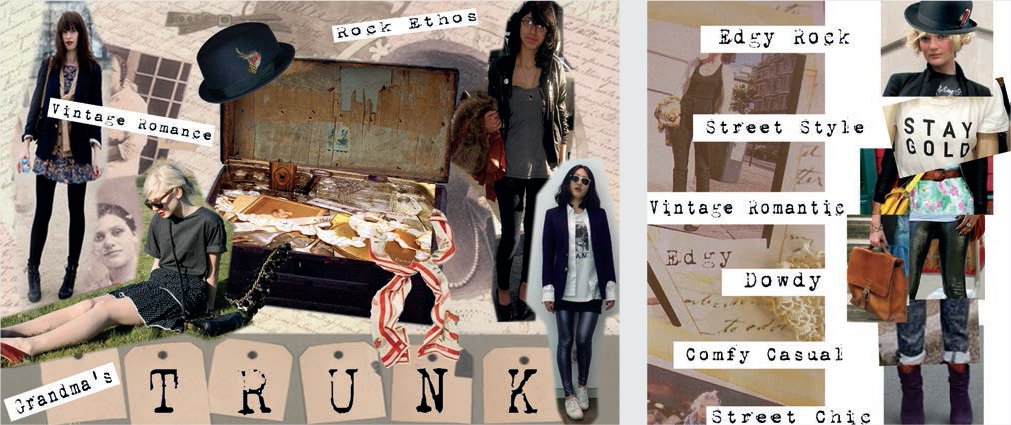
The concept board for Grandma’s Trunk. The imagery gives a visual feel for the brand and the customer.
Another model for analysing brand identity is Jean-Noël Kapferer’s Brand Identity Prism, first introduced in 1992. Kapferer’s six-sided model aims to capture the complexity of brand identity and the concepts behind it are perhaps harder to pin down than those of the simpler brand onion.
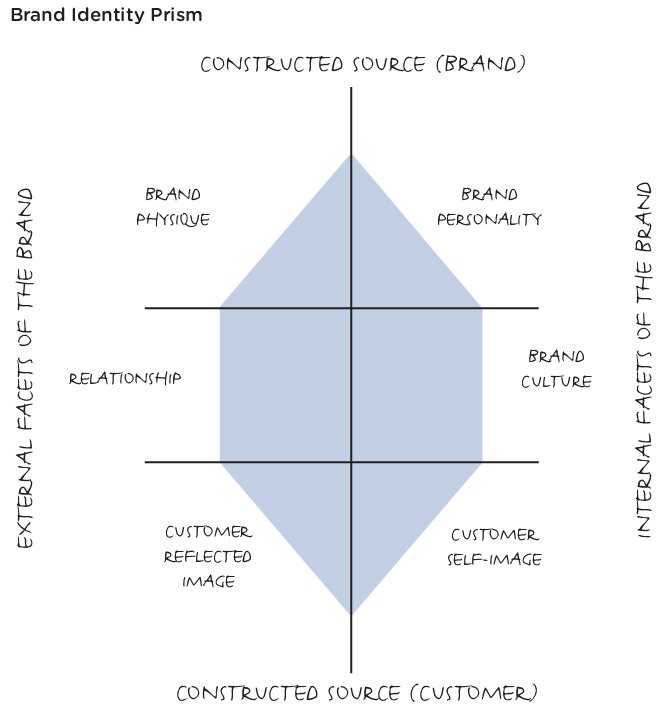
Source: Kapferer and Bastien, The Luxury Strategy 2009.
Both systems of analysis attempt to depict the internal and external aspects of brand identity. Kapferer’s model does this by dividing the diagram by a vertical axis, whereas in the brand onion the internal elements are placed towards the centre and external aspects, such as ‘the brand in action’ are situated on the outer layer of the onion.
•Physique – this equates to the essence of the brand as well as its physical features, symbols and attributes. At a symbolic level Nike is signified by the Swoosh, Levi’s by a red tab while Ralph Lauren is epitomized by Polo. The physical facet also comprises iconic products like Levi’s 501 jeans or Yves Saint Laurent’s ‘Le Smoking’ dinner jacket.
•Personality – the character, attitude or personality of the brand. Kapferer believes a brand should have a unique personality. In his book, Strategic Brand Management (1992), Kapferer modifies the definition of USP, changing it to become ‘unique selling personality’.
•Culture – a brand has its own distinctive culture and brand values. At Hermès the culture is built around luxury, craftsmanship and exceptional quality, at Ralph Lauren it is formed from a unique blend of preppy American, rugged outdoorsy casual and classic English tweed.
•Relationship – this relates to beliefs and associations connected with a brand. What does the brand promise? How is the brand perceived in the outside world? What does wearing a particular brand say about someone? It concerns social communication and the idea of using brands to belong to a style tribe or group.
•Reflection – this is the idealized image of the consumer as reflected in brand advertising. Kapferer describes this facet as the ‘external mirror’ of the brand. In the short film advertising Chanel Nº 5, Nicole Kidman reflects the allure, sophistication, elegance and mystery of the Chanel brand.
•Self-image – corresponds to the mental image consumers have of themselves when wearing the brand. Kapferer refers to this as the consumer’s ‘internal mirror’. Someone who wears Ralph Lauren might aspire to live the American dream or a person wearing Chanel may wish to feel independent and classy.
Branding: emotion and feeling
Branding aims to create connection by generating an emotional response. Brand personality and brand values are instrumental in achieving this. Teri Agins says in her book, The End of Fashion: “Fashion happens to be a relevant and powerful force in our lives. At every level of society, people care greatly about the way they look, which affects both their self-esteem and the way other people interact with them”(2000). Kapferer’s brand prism takes this into account by including relationship and self-image among its six dimensions. The brand onion positions the personality layer as the interface between the brand and consumer, both models can be used to analyse why consumers might connect with a particular brand and how they might feel when they do. Bernd H. Schmitt includes a chapter entitled ‘Feel’ in his book, Experiential Marketing. Schmitt explains that the aim behind the marketing and promotion of fashion and fragrance is to evoke certain types of emotions or feelings likely to make a customer want the brand; this is what Schmitt calls ‘sense marketing’. The naming convention for fragrances illustrates this concept; for example, Joy by Patou, Happy by Clinique, Pretty by Elizabeth Arden or Beautiful by Estée Lauder.
Establishing a brand is a long-term and costly process and companies do not take on this risky task lightly. Creating a brand with a clear identity takes time – it usually takes several years or decades to achieve brand status. Orla Kiely, for example, started her business in a small way working from home. It took approximately ten years for the company to expand and morph into the modern fashion lifestyle brand so loved today. Luxury brands like Fendi, Gucci and Prada started out as small family businesses. Fendi was a furrier, Gucci a handbag manufacturer and Prada designed and sold handbags, shoes and luggage. It was not until Mario Prada’s granddaughter Miuccia took the helm in 1978 that Prada started its journey to becoming a global fashion brand. Once a brand is recognized and valued by consumers then opportunity arises to capitalize on the power of the brand name and leverage the brand identity in order to take the brand forward. While it could be argued that a brand is formed in the mind and hearts of consumers, it is a valuable business asset that must be managed effectively from within the brand organization. Two of the most widely used strategies utilized in brand management are brand extension and brand licensing.
“Branding connects corporate strategy with consumer psychology.”
Pamela N. Danziger
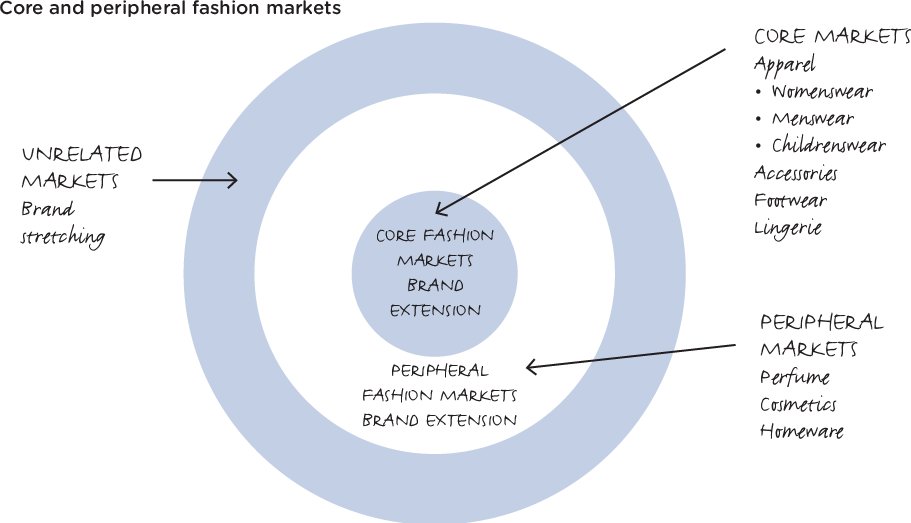
Brand extension and stretching
Brand extension and brand stretching relate to Ansoff’s matrix for growth discussed in Chapter 3 (see page 100). Brand extension allows a brand company to capitalize on the power of an existing band’s equity and value to launch new products in a broadly similar market. This relates to product development in Ansoff’s Matrix. Brand extension exploits a brand’s identity, associating the meanings and values behind it with new products. So an apparel supplier who manufactures a branded range of men’s performance and outdoor apparel would be extending their brand into another area of the apparel market if they launched a similarly branded womenswear collection. The benefit of brand extension in this case is that distributers and buyers are likely to perceive less risk when taking on the women’s version of the brand if they have had success selling the menswear, and end-consumers will have existing brand awareness.
If the company decided to utilize their established brand name in a completely different and unrelated market such as adventure travel then this would be termed brand stretching (‘diversification’ in Ansoff’s Matrix). Missoni have done this by creating the Missoni Home Collection as well as opening the Missoni Hotel in Edinburgh. When considering a brand stretching strategy it is important that there is a strong conceptual fit between the original brand and the new market. Missoni, for example, is a brand built around luxurious mixes of colour, texture and pattern which translates well into the arena of interior design.
Brand licensing
A brand is a business asset that should lead to higher profit levels for the operating company. One strategy utilized to achieve increased revenue and profit is licensing and this has increasingly become a favoured strategy for fashion brands wishing to achieve growth. According to the International Licensing Industry Merchandisers’ Association (LIMA), fashion licensing was worth US$ 775 million, equating to 14 per cent of the licensing industry revenue in 2008.
“Successful brand licensing can have a very positive effect on the overall perception and value of the brand… However, it is not an easy proposition and failure to manage licensing effectively might weaken or permanently damage the brand.”
Sean Chiles
Licensing is a business arrangement where a brand company sells the right to use their name to another company who can then develop, manufacture and market specified branded merchandise under licence. The manufacturing company (the licensee) will pay a royalty fee to the brand owner (the licensor). Royalty rates vary. The exact percentage is dependent on the time-frame of the agreement, the type of product involved, the financial investment, the time it takes to develop the product, and the volumes of merchandise predicted to sell. For women’s ready-to-wear, the standard rate will be between 3–8 per cent of the wholesale volume. According to Chevalier and Mazzalovo in their book Luxury Brand Management, perfume royalties are slightly less, usually 3–5 per cent of wholesale and export volume. This is because perfume licensing deals stipulate a high advertising-to-sales ratio (around 15 per cent), thus ensuring a high level of exposure for the product. By comparison, fashion ready-to-wear operates at a 2–4 per cent ratio. This is why perfume advertising is so prevalent and takes up so many more pages in a fashion magazine than adverts for clothing.
Licensing provides a means of diversification for a fashion brand, allowing it to expand into other markets and reach a broader audience. There is less risk attached to licensing compared to brand stretching because the brand company is not responsible for the capital investment or the costs involved in producing, distributing or marketing the licensed product.

The Missoni Hotel in Edinburgh.
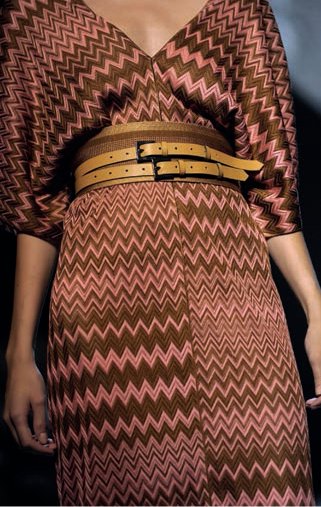
Missoni women’s ready-to-wear Spring/Summer 2009.
It is important therefore that licensing agreements are signed with companies with the correct expertise in manufacturing and marketing specific products. Avon has agreements to manufacture fragrances for Finnish brand Marimekko and French designers Emmanuel Ungaro and Christian Lacroix. Luxury footwear retailer Kurt Geiger signed a seven-year licence agreement in 2009 to distribute and sell Nine West women’s footwear, handbags and small leather goods in the UK and Ireland. Licensing allows the brand company to expand into fresh geographical market territories that it might not otherwise be able to enter. The Japanese company, Onward Kashiyama, holds the licence to manufacture and distribute Paul Smith womenswear as well as Calvin Klein, Jean Paul Gaultier and Sonia Rykiel. The Japanese market is extremely important for sales of global luxury and designer brands. Sales of British brands such as Paul Smith, Liberty and Hackett rose during 2008, even though clothing sales overall were down in Japan. Japanese consumers appreciate fashion with a British feel and these brands are perceived to have a classic and timeless image.
Brand repositioning
Repositioning is the process of redefining the identity of an existing brand or product in order to shift the position it holds in consumers’ minds relative to that of competitors. A brand organization may decide to alter its strategic direction and reposition a brand if the current positioning is no longer relevant or effective. The decision to do this might be required as a response to:
•Changes in the macro or micro marketing environment
•New brands entering the market
•Repositioning of competitor brands
•Shifts in consumer demand
Repositioning does not usually entail a change of brand name but might include updating and modernizing the existing logo. Rebranding refers to not only a potential repositioning of a brand but also to a complete change of brand name and logo. This usually occurs in response to a company takeover and could also include radical internal restructuring. Total rebranding is rare within fashion; it generally occurs in industries such as banking and insurance, although it could occur within garment manufacturing or in the chemical fibre industry.
The following section gives two examples of repositioning. The first illustrates how a brand was repositioned by changing the fashion level of its product and altering the structure of the product ranges. The second example shows how a brand updated its visual identity by modernizing its logo, store fascia, in-store design and packaging.
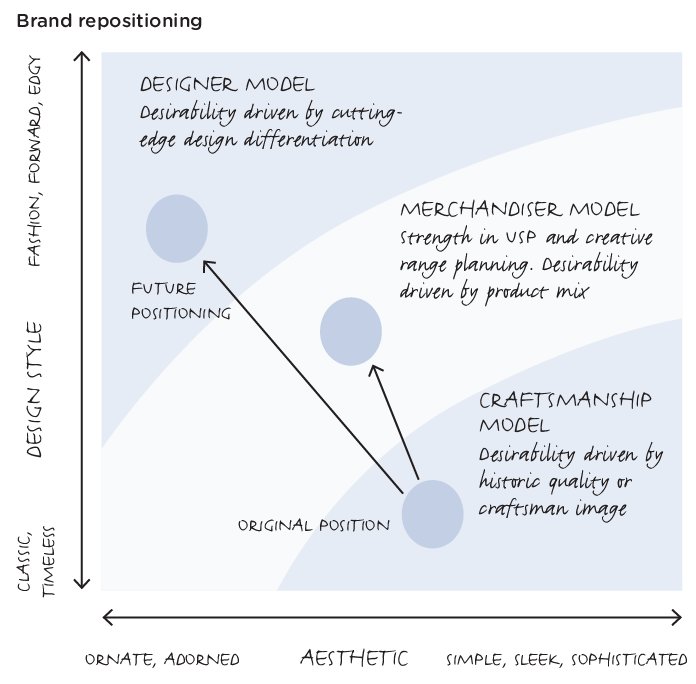
This repositioning map was created by brand management at MCM in order to visualize potential new positions for their accessory brand. The map shows the original position of the luxury accessory brand and two proposed positions for its future. The original positioning is based on MCM’s historic image and craftsmanship. The first new position, based on what MCM term the ‘Merchandiser model’, aims to retain the craftsman quality but drive desirability by creative merchandising and range planning. The second proposed position, the ‘Designer model’, is driven by cutting-edge design, potentially with a high-profile designer name as figurehead.
Source: MCM (2008)
Creating a contemporary luxury brand
Repositioning MCM
MCM (Mode Creation Munich) is a modern accessory and clothing brand that manufactures and sells quality leather travel goods, handbags and fashion apparel for both women and men. Sold by high-status retailers in the United States, the UK, Europe, Russia, Dubai and Asia as well as in MCM’s own boutiques in London, Berlin, Athens and Beijing, the brand is accessible in more than 260 points of sale worldwide. The company is run by Sung-Joo Kim, the Chairperson and CEO of the MCM Group. Kim is a business woman of great integrity and foresight. Predicting a likely economic downturn in 2008, she took strategic action to modernize and reposition the brand within the lucrative luxury accessories market. Sung-Joo Kim believes that the recession will necessitate change and that consumer tastes will shift in favour of a growing demand for what Kim terms “responsible luxury”. A key component of the strategy has been to revive and update a classic from the past. MCM reintroduced its signature Cognac Visetos collection for Spring/Summer 2009. In an article by Ann Hynek for FoxBusiness, Sung-Joo Kim explained the rationale behind this decision, “Going back to the brand’s traditional roots is a safe bet in uncertain times.”
The MCM repositioning strategy aims to modernize the brand, making it more fashionable and cutting-edge while at the same time maintaining the brand heritage and traditional values of quality, luxury and craftsmanship.
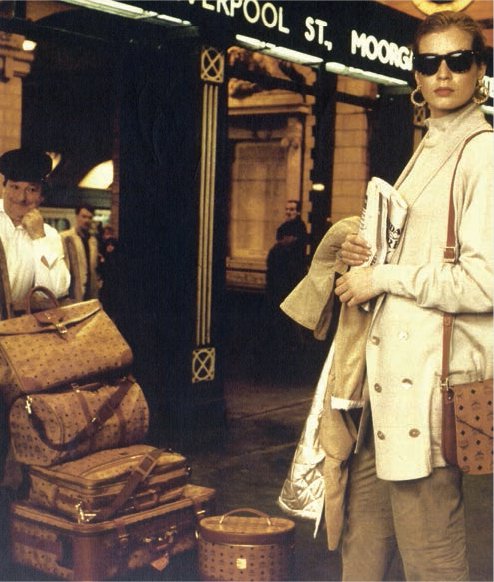
An MCM advertising image shows the original 1980s Cognac Visetos range.
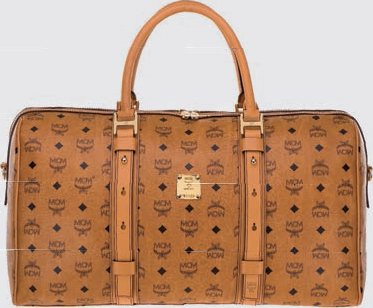
Bag from the updated and revitalized Vintage Visetos collection, Spring 2009. The logo-embossed, soft cognaccoloured leather is finished with brown trim and satin gold hardware. The introduction of sleek modern shapes and innovative detailing helps to give the product a more contemporary aesthetic and make it relevant for the twenty-first-century consumer.
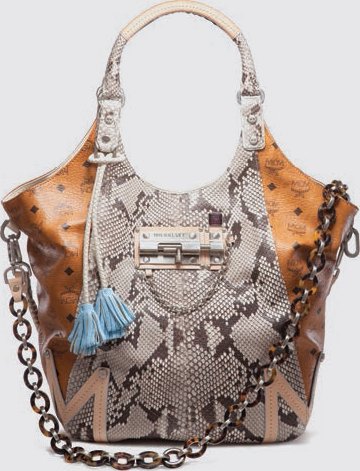
Bag designed by Michael Michalsky for the MCM Cognac Visetos range.
A fresh visual identity for an established business
Greenwoods
Greenwoods are a menswear specialist retailer and suit hire business established in 1860 by Willie Greenwood. The company, which has generations of experience in the menswear business, was family owned up until 2009 when it was bought by a Chinese company, Harvest Fancy Hong Kong Ltd., a unit of Bosideng International Fashion Ltd. Greenwoods trades from approximately 100 stores, situated mainly in the northern regions of the UK. It also has a website (www.1860.com) which focuses on the suit hire side of the business, specializing in traditional men’s eveningwear, morningwear and Highlandwear for formal occasions and weddings.
In 2009 an independent graphic design consultancy, Studio Ten and a Half, were commissioned to revitalize and update the Greenwood brand identity. Footfall had gone down and Greenwoods were loosing existing customers to competitors on the UK high street. The Greenwoods retail environment no longer looked fresh, the brand identity and message had become unclear and the brand personality was tired. There was a lack of coherence between the visual identity, the product on offer, the pricing strategy and the overall look of the retail environment. The bottom line was being affected and Greenwoods were struggling to compete. Research revealed that consumers valued Greenwoods for its heritage and specialist menswear knowledge, and they valued the individual attention and service offered by staff. They also thought of the brand as masculine and trustworthy. The new visual identity created by Studio Ten and a Half was designed to ensure that Greenwoods could capitalize on the tradition, heritage and trust that consumers so valued. The rebranding package included an updated design for the logo, a new store fit, a refresh of the fascia, new swing tickets, in-store signage, stationery and carrier bags.

The makeover of Greenwoods achieved by design consultancy Studio Ten and a Half illustrates the importance of having the right visual style for a brand. The new logo, signage and fascia build upon the original heritage of the brand. Traditional elements such as the gold lettering were retained, but the introduction of a more refined and modern typeface brought the overall look and feel of the brand up to date. The clean but traditional typeface creates a fresh and contemporary brand identity, and a simple palette using Greenwoods’ trademark green, gold, cream and grey ensures a balance between classic and modern. The brand’s long-standing heritage is communicated clearly by the use of the statement, ‘Menswear since 1860’.

